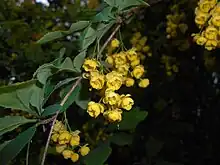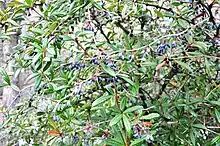Berberis lycium
Berberis lycium, called the Indian lycium, Indian barberry, or boxthorn barberry, is a species of flowering plant in the family Berberidaceae.[2] It is native to mountain slopes of the northwestern part of the Indian Subcontinent.[1] A widespread species, its fruit, called kasmal, is edible and is eaten fresh, cooked, and preserved.[3]
| Berberis lycium | |
|---|---|
 | |
| Flowers and leaves | |
 | |
| In fruit | |
| Scientific classification | |
| Kingdom: | Plantae |
| Clade: | Tracheophytes |
| Clade: | Angiosperms |
| Clade: | Eudicots |
| Order: | Ranunculales |
| Family: | Berberidaceae |
| Genus: | Berberis |
| Species: | B. lycium |
| Binomial name | |
| Berberis lycium | |
| Synonyms[1] | |
|
List
| |
References
- "Berberis lycium Royle". Plants of the World Online. Royal Botanic Gardens, Kew. Retrieved 18 January 2022.
- "Indian Lycium". Flowers of India. 2022. Retrieved 18 January 2022.
- Ali, Hazrat; Uddin, Shahab; Jalal, Sajid (2015). "Chemistry and Biological Activities of Berberis lycium Royle". Journal of Biologically Active Products from Nature. 5 (5): 295–312. doi:10.1080/22311866.2015.1073627. S2CID 74731704.
This article is issued from Wikipedia. The text is licensed under Creative Commons - Attribution - Sharealike. Additional terms may apply for the media files.